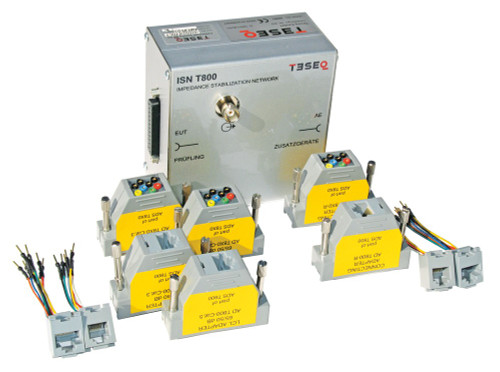Overview
Impedance stabilization networks (ISN, or with CISPR 16-1-2 called AAN: asymmetric artificial network) are defined for measuring of conducted common mode disturbances at information technology equipment (ITE) as required in CISPR 22 and CISPR 32. The ISN is placed between the equipment under test (EUT) and auxiliary equipment (AE) or load which are necessary for the operation of the EUT. The ISN establishes the common-mode termination impedance for the EUT’s telecommunications port during measurement and emulates the unsymmetrical contribution (longitudinal conversion loss, LCL) of the connected line. Different ISNs are available in relation to the line category, line numbers and pin-arrangement.
The ISN T8 is designed for measurements on up to four unscreened single balanced pairs and consists of one basic network (ISN T800) with D sub 25 connectors and special adapter sets. A set of adapters consists of two pieces of LCL adapters to arrange the lines and realize longitudinal conversion loss (LCL)- requirements for the EUT-side in relation to the use cable category (cat. 3, cat. 5) and one piece of connection adapter arranges the lines for the AE-side. Teseq offers two different adapter sets – ADS T800 and ADS T8x0. ADS T800 gives the connection to RJ45 sockets with pin-arrangements of EIA/TIA T568A respectively T568B. The adapter set ADS T8x0 offers changeable pin-arrangements via 1 mm banana connectors for each pin combination of RJ11/RJ45.
Features & Specifications of Teseq ISN T8:
- Frequency range: 150 kHz to 30 MHz
- Line parameters: 1 up to 4 pair(s)
- Power rating (EUT and AE port)
- AC max. voltage (line to ground): 63 V
- DC max. voltage (line to ground): 100 V
- Current max.: 600 mA (line), 1200 mA (pair)
- Test voltage: 200 VDC, 2 sec
- Common mode impedance (EUT port) 150 kHz to 30 MHz: 150 Ω ±20 Ω
- Phase angle (EUT port) 150 kHz to 30 MHz: 0° ±20°
- Coupling path (In / Out port / EUT)
- Connection: BNC 50 Ω
- RF voltage: <15 V
- Frequency range: 150 kHz to 30 MHz
- Voltage division factor (RF input to EUT port) 150 kHz to 30 MHz: 10 dB ±1 dB
- Transmission bandwidth (wanted signal) EUT / AE B3 dB: * > 100 MHz sin.
- LCL (EUT) *)
- Cat. 3 150 kHz to 30 MHz: 55 dB to 39.3 dB ±3 dB
- Cat. 5 150 kHz to 2 MHz: 65 dB ±3 dB
- Cat. 5 2 MHz to 30 MHz: 65 dB to 49.3 dB +4.5 / -3 dB
- Decoupling of common mode disturbances (EUT / AE)
- 150 kHz to 1.5 MHz / 30 MHz: ≥35 dB to ≥55 dB / ≥55 dB
- Crosstalk (PSELFEXT) (EUT / AE) 1 MHz to 100 MHz: ≥61 dB to ≥21 dB
*) all balanced parameters are in relation to a symmetrical load of 100 Ω











